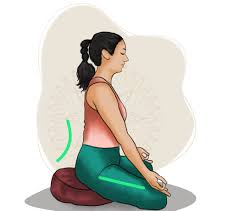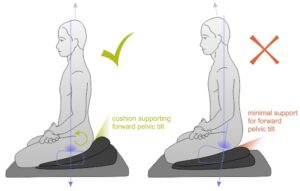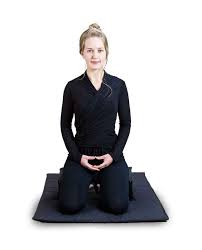

Forward head posture (FHP) is a common issue in today’s digital age, where prolonged screen time and poor posture habits strain the neck and spine.
This article delves into how seated meditation can be an effective tool to correct FHP. We will explore the mechanics of seated meditation, its role in fostering postural awareness, and techniques to align the spine and head correctly.
Alongside real-life examples and scientific references, this article outlines a mindful approach to addressing postural imbalances.
Index
- Introduction to Forward Head Posture
- The Role of Seated Meditation in Posture Correction
- Understanding the Mechanics of Proper Alignment in Meditation
- Key Techniques for Using Seated Meditation to Correct FHP
- Real-Life Examples of Success Stories
- Scientific Evidence Supporting Meditation for Postural Health
- The Psychological and Neuromuscular Benefits of Meditation
- Conclusion: The Integration of Mindfulness and Postural Awareness
Introduction to Forward Head Posture
Forward head posture (FHP) is characterized by the head’s forward positioning relative to the body’s vertical alignment, placing undue stress on the cervical spine.
This posture disrupts the natural curve of the spine, leading to muscle imbalances, increased neck and shoulder tension, and potential chronic pain.
Research in Clinical Biomechanics (Griegel-Morris et al., 1992) revealed that individuals with FHP experience significantly higher strain in their neck and upper back muscles compared to those with proper alignment.
How to fix hunchback requires a holistic approach involving strengthening weakened muscles, stretching tight areas, and cultivating postural mindfulness.
Seated meditation is particularly effective in enhancing body awareness and promoting correct alignment.
Example:
Anna, a 35-year-old accountant, struggled with persistent neck pain due to long hours of desk work.
She decided to conduct daily self posture checks at home.
By incorporating 15 minutes of seated meditation daily, focusing on alignment and diaphragmatic breathing, she improved her posture.
Within weeks, Anna experienced reduced neck tension and enhanced body awareness, demonstrating how mindfulness can complement traditional exercises in managing FHP.
The Role of Seated Meditation in Posture Correction
Meditation fosters heightened body awareness, helping individuals become more mindful of their alignment during daily activities.
This awareness is particularly beneficial for correcting forward head posture (FHP), as it emphasizes maintaining spinal neutrality and honoring the natural curves of the spine.
Unlike conventional exercises that target specific muscle groups, seated meditation integrates breathwork and mindfulness, addressing both the physical and psychological contributors to poor posture.
By bringing attention to the present moment and body mechanics, meditation helps mitigate compensatory patterns linked to FHP, such as neck strain or rounded shoulders.
Why Meditation Works?
When most people think of meditation, they picture a peaceful monk sitting cross-legged on a mountain, not someone trying to straighten their hunched back or fix forward head posture (FHP).
But here is the twist—meditation is one of the sneakiest, most powerful posture correction tools out there.
Let us dive deep (and we mean really deep) into how and why it works.
Improved Proprioception:
Think of proprioception as your body’s built-in GPS. Regular meditation, especially body scan or mindful awareness practices, strengthens your internal sense of where your limbs and spine are in space.
According to studies published in Frontiers in Human Neuroscience, consistent meditators show enhanced cortical thickness in areas responsible for bodily awareness.
Translation?
You become more aware when you are slouching—and more capable of self-correction. Ever suddenly notice your shoulders are halfway up your ears?
That is poor proprioception. Meditation fine-tunes that awareness.
Relaxation of Overactive Muscles:
FHP and poor posture often result from over-engaged neck, shoulder, and trapezius muscles.
Through breath-focused meditation, the parasympathetic nervous system (your “rest and digest” buddy) kicks in, reducing cortisol and muscle tension.
A deep inhale into the belly followed by a long, slow exhale is not just calming—it’s practically a mini-massage for tight muscles.
A 2017 study in Mindfulness found significant reductions in neck and shoulder pain among those who practiced daily mindful breathing for just 10 minutes.
Reinforcement of Alignment Habits:
Meditation creates a “posture checkpoint.” Sitting still with intentional posture, day after day, builds muscular memory.
It is not unlike practicing piano—you are training your body to return to that upright, relaxed baseline.
One patient with chronic slouching noted dramatic changes in their posture simply by meditating in a supported, aligned sitting pose every morning.
Neuroplasticity at Work:
Meditation literally rewires your brain.
According to Harvard researchers, just eight weeks of mindfulness practice can increase gray matter in the posterior cingulate (self-awareness), cerebellum (balance), and prefrontal cortex (attention).
This brain boost empowers better body awareness, conscious correction, and sustained postural habits. The facial expression and eye contact caused by nerd neck improve considerably when you meditate daily.
Emotional Posture Connections:
Believe it or not, your mood affects your posture—and vice versa.
Depression, anxiety, or stress often lead to collapsed postures. Meditation reduces anxiety and depressive symptoms, helping you open up physically.
That uplifted chest and engaged spine? It is not just alignment—it is emotional recovery too.
So the next time someone says meditation is “just sitting,” tell them it is sitting with purpose. With time, that purpose trickles down your spine and straightens it right up.
Understanding the Mechanics of Proper Neck Alignment in Meditation
Let us walk you through this in brief:
Proper Alignment During Seated Meditation
Maintaining proper alignment during seated meditation is crucial for reducing stress on the cervical spine and reinforcing the natural curves of the spine.
Aligning the head, shoulders, and pelvis in a straight line creates a balanced posture that minimizes strain and maximizes comfort.
This approach encourages better postural habits over time, helping to correct forward head posture (FHP).
Key Aspects of Proper Alignment
- Neutral Pelvis: Sitting firmly on the sit bones ensures an upright base. Elevating the pelvis slightly, such as by sitting on a cushion, prevents slumping and supports the lumbar spine.
- Aligned Head and Spine: The head should rest directly above the shoulders, with the chin gently tucked to maintain cervical neutrality. This reduces strain on the neck.
- Relaxed Shoulders: Shoulders should remain down and away from the ears, promoting relaxation and preventing upper back tension.
- Engaged Core: A gently engaged core stabilizes the spine, enhancing postural integrity.
Example
Lisa, a yoga enthusiast, practiced seated meditation on a cushion with her pelvis elevated.
She also indulged in chest stretches.
This adjustment provided lumbar support and encouraged her to keep her head aligned over her shoulders, significantly reducing upper spine strain.
Over time, her posture improved, and she experienced less neck discomfort.
Research published in The Spine Journal (Wong et al., 2017) supports this approach, highlighting the benefits of spinal alignment during meditation for alleviating musculoskeletal stress.
Key Techniques for Using Seated Meditation to Correct FHP
Let’s talk about forward head posture (FHP)—that sneaky culprit behind neck tension and upper back pain.
Did you know meditation can be your secret weapon to fight it?
That is right, mindfulness isn’t just for your mind; it is for your muscles too!
Let’s dive into a few effective techniques, backed by science, that can help you straighten up—literally.
1. Body Scan Meditation
Imagine scanning your body like a human X-ray, from head to toe. This technique highlights areas of tension, like those pesky tight neck muscles, and lets you consciously adjust your posture. A study in Mindfulness (Zeidan et al., 2012) found that body scan meditation not only improves focus but also reduces muscle tension—perfect for combating FHP.
2. Breath-Focused Meditation
Take a deep breath and feel your spine lengthen. Breathing deeply engages your diaphragm, naturally relaxing overactive neck muscles and encouraging a taller, more aligned posture. Bonus: Slow breathing reduces stress, which is a major player in poor posture.
3. Visualization Techniques
Picture this: a golden string pulling the crown of your head toward the sky. It is not magic, but it might feel like it! Visualization reinforces alignment by retraining your brain to recognize proper posture.
4. Mindful Sitting
Meditation habits spill over into daily life. When you are mindful of neck alignment during meditation, it becomes second nature in everyday activities, from typing emails to standing in line for coffee.
See?
Meditation is not just zen—it is your posture’s best friend!
Lisa’s Digital Detox and Posture Awareness
Lisa, a 30-year-old graphic designer, spent most of her day glued to her laptop.
Over time, her head crept forward like a turtle reaching for its shell, leading to chronic neck pain. Desperate for relief, Lisa decided to try seated meditation.
Every day, for 15 minutes, she sat with her head stacked directly above her shoulders and focused on diaphragmatic breathing.
She also visualized a string gently pulling her head upward, elongating her spine.
Within two months, something magical happened.
Lisa noticed her neck tension easing, her shoulders relaxing, and her posture improving—not just while meditating but throughout her workday.
The best part?
She felt more energized, and those nagging afternoon headaches became a thing of the past.
Tom’s Running Recovery
Tom, a 35-year-old marathon runner, loved hitting the pavement but hated the foot arch pain that started creeping in.
After a gait analysis revealed his forward head posture was throwing off his running form, Tom turned to meditation.
Guided sessions with alignment cues helped him reposition his head and realign his entire kinetic chain.
The result?
Tom’s running posture improved, his foot pain vanished, and his stride became more efficient.
Meditation did not just help him physically; it also gave him mental clarity to focus during races. Tom now swears by seated mindfulness as part of his training regimen.
Who knew sitting still could get you moving better?
Scientific Evidence Supporting Meditation for Postural Health
- Improved Postural Control A study in Clinical Rehabilitation (Cramer et al., 2016) found that mindfulness-based interventions, including meditation, improved postural control in individuals with chronic neck pain.
- Reduced Neck and Shoulder Tension Research in The Journal of Pain (Morone et al., 2008) highlighted the role of mindfulness in reducing musculoskeletal pain caused by poor posture.
- Enhanced Neuromuscular Coordination Studies, such as one published in NeuroImage (Zeidan et al., 2015), show that meditation enhances neuromuscular coordination, which aids in maintaining proper alignment.
The Psychological and Neuromuscular Benefits of Meditation
A quick look at this aspect in brief:
Reducing Stress-Related Tension:
Stress does not just mess with your mind—it takes a toll on your body, especially the neck and shoulders.
When you are stressed, your hypothalamic-pituitary-adrenal (HPA) axis activates, flooding your body with cortisol.
This “fight-or-flight” hormone heightens muscle tension, particularly in the upper back and neck, exacerbating forward head posture (FHP).
Meditation provides a powerful antidote by calming the HPA axis and lowering cortisol levels. Focused breathing and mindfulness techniques promote relaxation and release built-up muscular tension.
Research in Psychoneuroendocrinology (Rosmond et al., 2005) underscores how meditation effectively reduces stress markers, alleviating the physical discomfort tied to chronic stress.
Enhancing Proprioception:
Meditation does not just relax you—it teaches you to tune into your body. By enhancing proprioception, or the body’s sense of spatial positioning, meditation helps you become more aware of alignment issues.
Through consistent practice, you can consciously correct your posture, reinforcing healthier habits. This mindfulness makes it less likely to slip back into FHP during daily activities like typing, texting, or sitting.
Over time, the improved body awareness cultivated through meditation becomes second nature, helping you maintain proper alignment throughout the day. It is a simple yet effective way to retrain your posture for the long haul.
The Integration of Mindfulness and Postural Awareness
Seated meditation is not just about finding inner peace; it is a hands-on (or rather, hands-off) way to address forward head posture (FHP).
Picture this: you are sitting quietly, focusing on your breath, and without even realizing it, you are teaching your body better alignment.
Meditation blends breathwork, body awareness, and gentle alignment techniques to create a holistic solution for FHP. Sure, it is not an overnight fix—but progress is gradual and deeply satisfying.
Imagine Lisa, who added just 10 minutes of seated meditation to her day and found her chronic neck tension easing within weeks.
Pairing meditation with ergonomic adjustments and posture-friendly exercises (such as neck tilts or scalene stretches) makes the results stick, ensuring a sustainable posture reset.
Science backs this up too! Studies validate the role of mindfulness in improving musculoskeletal health, making meditation more than a mental reset—it is a way to foster a healthier mind-body connection.
With daily practice, meditation becomes the bridge to lasting alignment and comfort.
References:



